
Lise Swenson's newest project "Mission Movie" by Kathleen Quillian
Mission Movie is the first collaborative feature film by award-winning and long-time local media artist and activist Lise Swenson. For five weeks in May and June, prior to the official release of the film, Swenson and her crew transformed ATA's front windows into the Mission Movie Headquarters to help promote the film. In May, I had the pleasure of meeting with Lise, who is a founding member of ATA and a former teacher of mine from SFAI, to discuss her film. Unfortunately, there was a slight technical problem with my recorder so I wasn't able to include any of the interview in the first "discussion" published in the zine. She graciously agreed to meet with me again for another interview at some point during her extremely busy schedule prior to the release of the film. Between the two interviews, Lise had finished the film, presented a first-cut of it for a press screening (which I attended), presented a second-cut of the film for a VIP screening, organized several fund-raising events, was involved in at least one film-making symposium (that I know of) and had an interview for a tenure position at UC Davis. For our second interview, I was able to talk with both Lise and Harjant Gill, one of Mission Movie's crew members who had a number of roles, including Casting Director, Script Co-Writer and even a small acting part in the film. Below is the original "discussion" with Lise published in the webzine, followed by the second interview between me, Lise and Harjant.
The script of the movie, derived from real-life stories and filtered through fiction, aims to tell the story of the Mission neighborhood in San Francisco ("72,634 residents, 196 nationalities, 2 square miles, 1 movie"). It is a bilingual urban drama about what happens when very different people try to share a neighborhood. The project was launched in 2002 as San Francisco, and most notably the Mission District, was still reeling from the results of a population growth and gentrification (spurred by the dot com boom of the late 1990s).
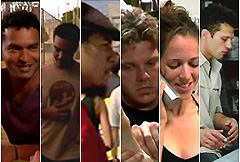
Mission Movie, "72,634 residents, 196 nationalities, 2 square miles, 1 movie"
Swenson thrives off of collaborations, and this project was certainly an ultimate example of that. She and the core movie production crew assembled a Community Advisory Group (CAG), made up of members of the Mission District community, to help keep watch over every aspect of presentation throughout the entire production of the film. The script was conceived and assembled under the constant watchful eye of the CAG, who were responsible for protecting the stories of the Mission and its residents.
In 1995 Swenson was commissioned to make a video about HIV awareness with a group of high school students from the Mission District. Swenson's relationship started out very rocky the kids who felt that they were being exploited for their social position. After butting heads with them, she finally let them decide what kind of movie they wanted to make with the resources they were given and this ended up becoming "Love Between a Boy and a Girl," an experimental documentary about AIDS. The success of this project led her to co-found TILT (Teaching Intermedia Literacy Tools), a nonprofit that works within school programs and community organizations to teach the fundamentals of moviemaking. Some of the kids from that first documentary went on the assist in the production of "Mission Movie."
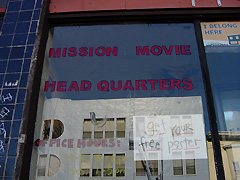
Artists' Television Access is "Headquarters" for Mission Movie for the month of May
We are honored to have Lise Swenson and the Mission Movie crew in residence at ATA and we hope that you come by to talk to them about their project.
interview, May 21, 2004, with Lise Swenson and Harjant Gill
K: I was watching your tape of early work... obviously it's from the 80s judging by your hairdo!
L: Which tape?... Oh my God! That was made in like 82... hey, I was just learning to make video!
K: ...you can definitely see your interest in narrative...
L: Yeah. How funny. That's stuff I don't even let myself look at any more. But it's good that it's there.
K: And... you're working with groups in almost every single one of them.
L: Yeah.
K: I just imagined you... as a video installation artist.
L: Oh, definitely not. I definitely started with single-channel. I didn't make my first installation until 86. I didn't really start making installation work until 92 and I've done a lot of it in the last ten years.
K: Actually Gilbert and I were talking about doing something with a whole bunch of monitors and his comment was that we should "Lise Swenson-it" and I knew exactly what he was talking about
L: (laughs) Yeah, I'm just happy when there's a big pile of VCRs and TV sets. I miss art-making a lot right now.
K: It definitely seems that [Mission Movie] is about a certain time period. Do you think that it still holds up now? I mean obviously it's about, as you said, fighting for space. But now people are not as crowded in the neighborhood.
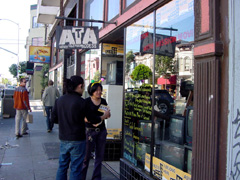
ATA's storefront windows are filled with video monitors showing clips from the movie
L: I think it's a relevant message, period. I think if you go to any urban center, whether it's filled or not filled, it's basically contested. I mean, space is contested by gang members... and certainly the more people who are in the space, tempers will flare and the more contested the space will be.
Certainly when the initial grant and project description was written space was a hot commodity and it was something that I was personally involved with as an activist and an artist... in 1999-2000, I was in revolt in the street as were many artist-activists. By doing that, by expressing ourselves I think, for me, it gave me cause to reflect on my anger and how that was affecting recapturing or reclaiming my space. And I realize that shouting can be good for the soul but it doesn't really change too much...
In the summer of 2001 I did the "Living Laboratory" which was "okay, all of these white artists were out yelling in the streets about displacement and gentrification but what do all the other people in the neighborhood think about it?" and really trying to reach out past that predictible comfort zone of me as an individual, white artist and asking other people in the neighborhod from different ethnic backgrounds, different class backgrounds and different experiential backgrounds how they felt about their neighborhood being... in flux. And it was really interesting to me that a lot of working class Latino families said "well, it's a bummer when you can't afford your rent anymore but really what bothers me right now is drugs and crime on my front doorstep"...it was really important for me to... not make assumptions about other people's experience. So "Living Laboratory" was an invitation to artists and non-artists from wildly different backgrounds to participate in a show using the Lab as a space in a living laboratory to investigate notions around space and belonging and history. And it totally educated me. So, I think that Mission Movie came more directly out of that which was a movement away from the kind of binary stance of displacement and gentrification is bad, you know, good-bad-right-wrong and more towards, okay, let's look at the bigger picture here and look at how these people are responding... to this idea of displacement and belonging. Like in the Cruz family story in Mission Movie, the father character's relationship to belonging had nothing to do with the size of their apartment or whether they were getting kicked out, it had to do with him feeling invisible in this culture, so, really complicating that idea of belonging and space. The third generation Mexican restaurant owner, she made assumptions about her space too. She keeps questioning why she's being attacked, because she's been here all her life. Her line is literally "Go home? I AM home!" and while she's home... she's making assumptions about her place there too when she brings in cultural icons of a different kind of lifestyle into a neighborhood that is identified with a certain kind of life. I think, at its best, Mission Movie invites us all to think about our relationship to the spaces we inhabit...and how we are going to have to learn how to get along with each other to make it all work out.
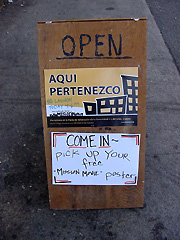
Posters in spanish and english promote the movie
K: Have you come up against any resistance similar to [working with the high school kids on the AIDS documentary in 1995] from anyone?
L: I'm a lot smarter about this stuff now than I was in 1995 when I was first doing that project here in the Mission. And as a result...I'm a better strategist than I used to be. I can foresee these kind of complex...as a result I put together a core team, over two years ago now, that was a pretty diverse core team that was a bilingual core team, and from there, the first thing we did was to get an advisory group which was truly diverse...which had... many perspectives represented. So, I suppose I can say that I did my homework up front this time but it doesn't mean that there weren't pitfalls and there wasn't held-beliefs and hostilities and racism coming from all different kinds of people towards all different kinds of people. What was hard for me on this project was, especially as the project started to grow and we started to bring on cast members that had very ethnically or sexually-preferenced identities formulated already, how do you start bridging across these identity formations? I mean they're on this project because they believe in the project but they are bringing held-beliefs about straight people, white people, Latin people...all of a sudden they're all in the same room together.
I'll tell you it was hard. It was so hard to try to call it when we saw it, but, in the end, it totally paid off. It's one thing I've really learned from Mission Movie is if you really did your homework and if you're really frank, you can say the wrong thing but you're coming from a place that's not becoming hostile or upset and it really pays off.
K: I would've liked to have been in that room to see how you guys operated, having so many different people.
L: It was mostly pretty good... [to Harjant] like when we went from the core team, to the Community Advisory Group, and bringing on all those different people from all those different backgrounds with totally different agendas...and then when we brought cast people on like Ben Rojas who really is...
H: They added a whole other layer...
L: Telling him [Harjant] that it was inappropriate to have an Asian...he ended up being one of the teenagers [in the film] because some of the teenagers didn't show up...Ben Rojas saying that Latino teenagers would not be hanging out with an East Asian kid. I mean saying that it's not right.
H: He was saying that I shouldn't be representing a Latino teenager.
L: which, you were not saying you were representing...so, but, held-beliefs, like what the Mission should be, what the Mission is, who the Mission is for...he's a great thinker but he... comes from a very brown-power perspective, so it was really hard for him to work with a white director and a diverse team of people that were backing him up that weren't Latino. If it had been his movie, it would have been Latino-specific...so it's really like how do you talk across those held-beliefs? You have to if you're going to move forward.
H: And having people who were more involved in the technical aspects...who come from the film-making world...
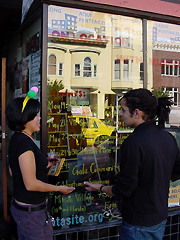
A member of the Mission Movie volunteer crew and Harjant (right) discuss
L: Oh God, that's a really great point... who talk to people in these ways... like bringing that white male, professional ethos in, which is competitive and, you know, if I talk louder, I'm top dog, and I won't listen to the female director and I'll shout at whoever I want to shout at and I'm like "Woh, come here. Uh-uh! Not on this set!" This set is way too volitile for that. This set is way too sacred to act like that. It's... too volitile. We had people who were going to beat other people up, occasionally, on the set...it was a little scary...
H: There were people who were ready to walk off...
L: Yeah. People got offended.
H: People would hold grudges for a long time.
L: Sometimes it was because of the content of the film too. Like the... two scenes where the kids yelled "gay" at each other, it was really hard. Some of our queer crew members had a really hard time with it. It wasn't in context... when you have that much diversity you're going to hit those walls. But when you get through them, and we got through all of them... No one actually, I can't think of anyone who actually really dislikes anyone else from the whole cast or crew...
H: And who decided that they didn't want to do it anymore. At the end of the day, we all ended up working our problems out.
L: And liking each other. We've sort of identified this weird, kind of Frankenstein-esque family at the end of the day too. And that's an accomplishment.
K: I hope you've documented the whole process...
L: A lot of it.
K: ...because that would almost be like a second chapter of Mission Movie... how you guys actually approached the project.
L: Well, that's what we're writing grants for right now is to do a DVD and educational element where we actually investigate how you make a community [project]...I mean it's a film by Lise Swenson, but only-just...really, I mean...it's more like a film by... our credits are in place now. You didn't see the final credits.
K: I saw a lot of them.
L: That ain't NOTHING girl! That's nothing compared to what they are now.
H: We had people from 15 different places...in the world...who actually came on board to work on this project. Like I grew up in India and Adriana grew up in Bolivia. So it was like a really diverse group. And that's not even counting the nationalities.
L: One day our unit production manager was bored and she decided to try to identify the different nationalities on our team. It's pretty cool. It's amazing. And I think that the people who were really committed to this project, who really had a high presence, who got involved and then who got more invested and involved were the people who really enjoy diverse settings. We all sort of celebrate each other's difference, I think, in the end. It's good. It's hard though. And I can speak from my experience too, that if you aren't diligent about maintaining a diverse perspective, you might likely get a bunch of educated, white people standing around, running the show. It's self-selecting. I mean, why would someone like Ben Rojas select to work with three middle-aged white women?
K: [to Harjant] You were very much involved, it seemed like, in every aspect of the project.
H: Pretty much, yes. My primary job was Casting Director.
K: Which was an amazing job, I have to say.
H: Thank you. Because when I started as a casting director I didn't know what the hell I was doing...but, after going through... I mean, we tried out... close to 200 people that we auditioned for this film before we made our 15 selections for the cast. So, it was a long process. We started two months prior to rehearsals... doing auditions... and that was a really interesting and...
L: challenging? I think the word you would use is challenging?
H: ...challenging process just because... the script wasn't really written and the characters weren't really defined.
L: We had a script outline.
H: So...we were...looking at it from two different perspectives and then after that...a lot of our script changed based on who was a good actor and who we really liked and who really came through, and we were like, okay, we can change the script around a little to accommodate this person...
L: The restaurant owner was Antoni-o until we met Antoni-a.
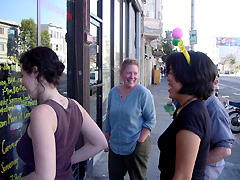
Lise Swenson (middle) and a few members of the Mission Movie volunteer crew
H: ...it was all a process. We would walk into rehearsals and we were like "I have this idea...we should have this..." and Lise would say, you know, "it shouldn't be a cat, it should be a dog"...
K: "It should be MY dog!"
H: (laughs) the dog...
L: Well, you know... my dream life has become one of... my biggest fountains of information. I would wake up and think, "We can't direct a cat!" That's ridiculous! You can't direct a cat! You can direct a dog...
H: We'd all come up with these crazy ideas.
L: And we had endless meeting too. I mean...all the rehearsals were video-taped too... well, even before that happened, the whole scripting process was a very in-depth process. There were about five of us that were really in-depthly involved... seven of us. It's sort of amazing how we got to where we got to.
K: So you guys actually wrote the script...
H: No, we wrote the script outline based on what the community advisory group had told us and then we took that script outline to the actors and had them improvise on it and then based on the way the actors performed it, we changed it around a little bit to fit their acting style...
L: We pulled the dialogue literally from their mouths. Me and the script writer... literally worked with the videotaped scenes. I would indicate the dialogue that worked and he was a transcript writer, he would pull it out, and I would give a last pass at it, and then we would take it back to them. We rehearsed them to see if it worked. We'd tweak it. So, it was always a two-step process. Then we'd take the scene back to them, we'd videotape that and we'd compare the script with the videotape and then hone it from there, and then give them the script to memorize.
H: Have you ever heard of anyone doing anything like that before?
L: Mike Leigh does something very similar. He takes a lot longer. We did it in about two months, which is insane... it turned out fine... a lot has been cut too... our first cut of the movie is close to two hours.
H: Yeah, if we wanted to, we could have made a short series.
K: You should!
L: I think that's ripe for the picking. I think that... any like-immigrant-urban-in-flux neighborhood in America would be a great site for a series.
K: Yeah. Hey, I would encourage it.
L: Who knows? HBO's going to be seeing our film in July... You're right though...we would be crazy not to formalize or document this process in some way as a model for other community groups to use, to a lesser or greater extent. I mean, it's based on the TILT model... and it works.
Mission Movie website:
http://www.missionmovie.org